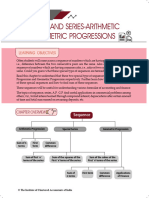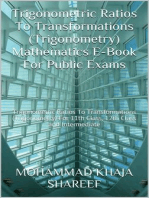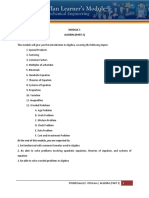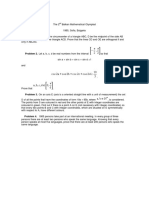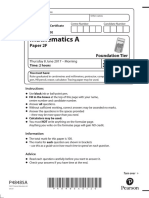Module+3+ +Engg+Math
Uploaded by
Satoru FujinumaModule+3+ +Engg+Math
Uploaded by
Satoru FujinumaMODULE 3
ALGEBRA (PART 3)
TRIGONOMETRY (PART 1)
Introduction:
This module will discuss the following topics in Algebra:
1. Progression
2. Principles of Counting
3. Permutation
4. Combination
5. Theory of Sets
6. Venn Diagram
This will also discuss the following topics in Trigonometery:
1. Historical Timeline
2. Angles and its Measure
3. Sum of Angles
4. Graphical Relations of Angles
5. Schwarz’s Inequality
6. Classification of Triangles
7. Intersection of Triangles
At the end of this module, you are expected to:
1. Be able to identify different types of progressions and be able to solve problem involving
progressions;
2. Be able to solve problems involving principles of counting;
3. Be able to solve permutation and combination;
4. Be able to identify/define theory of sets and use Venn Diagrams;
5. Define Trigonometry and its branches;
6. Define terms involved in trigonometry;
7. Identify and define different types of triangles
Hewlett-Packard |ALGEBRA (PART 3), TRIGONOMETRY (PART 1) 1
Discussion:
PROGRESSION
- It is the sequence of numbers called terms, each of which, after the first is derived from the
preceding one.
Types of Progression:
- Arithmetic Progression
- Geometric Progression
- Infinite Geometric Progression
- Harmonic Progression
1. Arithmetic Progression – is a sequence of numbers called terms, each of which, after the first is
derived from the preceding one by adding to it a fixed number called the common difference.
a. nth term of AP
an = a1 + (n – 1)d
an = am + (n – m) d
b. Sum of AP
𝑛
S = 2 (𝑎1 + 𝑎𝑛 )
𝑛
S = 2 (2𝑎1 + (𝑛 − 1)𝑑)
c. Common difference of AP
d = a2 – a1
d = an – an-1
d. Relation between terms
a3 – a2 = a2 – a1
e. Arithmetic Mean
𝑎1 + 𝑎3
Am = a2 =
2
𝑎1 + 𝑎2 + 𝑎3+ …+ 𝑎𝑛
Am = 𝑛
Hewlett-Packard |ALGEBRA (PART 3), TRIGONOMETRY (PART 1) 2
Where:
an = nth term S is the sum of the terms
n is the mber of terms am is the mth term
d is the common difference Am is the arithmetic mean
Example:
Find the arithmetic mean of 2 and 6
2+6
Am = 2
=4
Find the 30th term of an AP 4, 7, 10...
an = a1 + (n – 1)d
a30 = 4 + (30-1)(3)
a30 = 91
A stack of bricks has 61 bricks in the bottom layer, 58 bricks in the second layer, 55 bricks in the third
layer and so until there are 10 bricks in the last layer. How many bricks are there together?
𝑛
S = 2 (𝑎1 + 𝑎𝑛 )
𝑎1 = 61
𝑎𝑛 = 10
To solve for n:
an = a1 + (n – 1)d
10 = 61 + (n -1)(-3)
n = 18
then,
18
S= (61 + 10)
2
S = 639
Hewlett-Packard |ALGEBRA (PART 3), TRIGONOMETRY (PART 1) 3
If the sum is 220 and the first term is 10, find the common difference if the last term is 30.
2. Geometric Progression – is a sequence of numbers called terms, each of which, after the first is
obtained by multiplying the preceding term by a fixed number called the common ratio.
a. nth term of GP
an = a1 rn-1
an = amrn-m
b. Sum of GP
𝑎1 (1− 𝑟𝑛 )
S= 1−𝑟
for r < 1.0
𝑎1 (𝑟𝑛 − 1)
S= for r > 1.0
𝑟−1
c. Common ratio of GP
𝑎 𝑎 𝑎𝑛
r = 𝑎2 = 𝑎3 = 𝑎
1 2 𝑛−1
d. Relation between terms:
𝑎3 𝑎
𝑎2
= 𝑎2
1
Hewlett-Packard |ALGEBRA (PART 3), TRIGONOMETRY (PART 1) 4
e. Geometric Mean
GM = a2 = √𝑎1 𝑎3
GM = 𝑛√𝑎1 • 𝑎2 • 𝑎3 •… 𝑎𝑛
Example:
Find the geometric mean of 2 and 8
GM = √(2)(8) = 4
Find the sum of the first 10 terms of the geometric progression 2, 4, 8, 16...
𝑎1 (𝑟𝑛 − 1)
S= for r > 1.0
𝑟−1
2(210 − 1)
S=
2−1
S = 2046
3. Infinite Geometric Progression – a geometric progression that approaches infinity.
𝑎1
S∞ =
1−𝑟
Note: When r < 1 and n approaches infinity the value of rn approaches zero. The above equation is
derived from GP of r < 1.0
Example:
2
Find the sum of the infinite geometric progression 6, -2, 3 …
𝑎1
S∞ = 1−𝑟
Where:
−2 1
r= 6
= −3
then,
6 18 9
S= 1 = 4
= 2
1+
3
4. Harmonic Progression – a sequence of numbers called terms in which the reciprocals form an
Arithmetic Progression. (Example: ½, ¼, 1/6, 1/8...)
Hewlett-Packard |ALGEBRA (PART 3), TRIGONOMETRY (PART 1) 5
Example:
The third term of a harmonic progression is 15 and the 9th term is 6. Find the 11th term.
Solution:
In finding the terms of a harmonic progression, solve it using arithmetic progression, then get its
reciprocal to obtain the term in harmonic.
Terms HP AP
3rd 15 1/15
9th 6 1/6
11th ? X
a9 = a3 + (9-3)d
1 1
= + 6𝑑
6 15
1
d = 60
The 11th term (AP):
1
a11 = a3 + (11-3)( )
60
1 1
a11 = + 8( )
15 60
1
a11 = 5
The 11th term (HP):
a11 = 5
PRINCIPLES OF COUNTING
Principle 1: Simultaneous or Successive Events
If the first event can occur in “h” ways and if after its occurrence or at the same time another event can
occur in “k” ways, then two events will happen in h x k different ways.
Example: A building has five outside doors. In how many ways can a person enter and leave by using
different doors.
Hewlett-Packard |ALGEBRA (PART 3), TRIGONOMETRY (PART 1) 6
N = 5(enter) x(and) 4(leave)
N = 20 ways
Principle 2: Mutually Exclusive Events
If the first event can occur in “h” ways and another event can occur in “k” ways, if the two events are
mutually exclusive, then one or the other event can occur h + k different ways.
Example: In a deck of 52 playing cards, in how many ways can a person pick up a queen or aking?
N = [4](queen) +(or) [4](king)
N=8
ARRANGEMENTS
If things are selected then it can be arranged in an orderly manner or arrange them by group. In
mathematics, arrangements can be classified as either permutation or combination.
Permutation – an ordered arrangement of any element of a set
Hewlett-Packard |ALGEBRA (PART 3), TRIGONOMETRY (PART 1) 7
Example:
1. Permutation (Things Alike)
How many permutations can be made from the word MISSISSIPPI?
Solution:
n = 11, I = 4, S = 4, P = 2
11!
P = 4!4!2!
P = 34,650
2. Cyclic Permutation
How many ways can 4 people form a circle?
Solution:
N = (n – 1) !
N = (4 -1) !
N = 6 ways
PRACTICE EXERCISE:
Permutation of different things taken r at a time
1. If 15 people won prizes in state lottery, in how many ways can these 15 people win first, second,
third, fourth, and fifth prizes? Answer: 360, 360 ways
2. How many 4 digits number can be formed without repeating any digit from the following digits: 1, 2,
3, 4, and 6? Answer: 120 ways
Hewlett-Packard |ALGEBRA (PART 3), TRIGONOMETRY (PART 1) 8
Permutation of n different things taken n at a time:
1. In how many ways can a set of 6 distinct books be arranged in a bookshelf? Answer: 720 ways
2. How many permutations are there if the letters PNRCSE are taken 6 at a time? Answer: 720 ways
Combination – a grouping arrangement of any element of a set
Example:
1. Six people are on a sinking yacht. There are 4 lifejackets. How many combinations of survivors are
there?
Solution:
6!
6C 4 =( = 15
6−4)!4 !
Hewlett-Packard |ALGEBRA (PART 3), TRIGONOMETRY (PART 1) 9
2. In how many ways can you invite one or more of your five friends to a party?
5C 1 or 2 or 3 or 4 or 5 = 5C1 + 5C2 + 5C3 + 5C4 + 5C5 = 31 ways
Alternate Solution:
5C 1 or 2 or 3 or 4 or 5 = (2)n-1 = (2)5 – 1 = 31 ways
THEORY OF SETS
Set – any defined collection of elements, class, things, or object
Basic Set Operations:
Union – The union of sets A and B is the set of all elements which belong to A or to B or both.
Example:
A = { j, a, m}
B = {m, a, n}
A ᴗ B = {m, a, j, n}
Intersection – The intersection of sets A and B is the set of elements which belongs to A and also
belongs to B
Example:
A = { j, a, m}
B = {m, a, n}
A ᴖ B = {m, a}
Difference – The difference of two sets A and B is the set of elements which belong to A but does not
belong to B
A = { j, a, m}
B = {m, a, n}
A – B = {j}
B – A = {n}
Hewlett-Packard |ALGEBRA (PART 3), TRIGONOMETRY (PART 1) 10
Complement – The complement of set A is the set of elements which do not belong to A, that is; the
difference between universal set and A.
A = {2, 4, 6, 8...}
Then
Ac = {1, 3, 5, 7...}
VENN-EULER DIAGRAM OF SETS:
A union B: AᴗB
A intersection B: AᴖB
A difference B: A – B
Hewlett-Packard |ALGEBRA (PART 3), TRIGONOMETRY (PART 1) 11
Complement: (AᴗB)C
Example:
1. In a class of 40 students, 27 like Calculus, and 25 like Chemistry. How many students like both Calculus
and Chemistry?
Let: x = number of students who both like Calculus and Chemistry
(27 – x) + x + (25 – x) = 40
x = 12 students
2. In a survey concerning the number of students enrolled in Mathematics subject, it was found out that
30 enrolled in Algebra, Calculus, and Trigonometry; 40 in Algebra and Trigonometry, 45 in Trigonometry
and Calculus, 50 in Algebra and Calculus, 80 in Algebra and 70 in Calculus. If there are 130 students in all,
how many students are enrolled in Trigonometry?
Hewlett-Packard |ALGEBRA (PART 3), TRIGONOMETRY (PART 1) 12
X + 5 + 20 + + 10 + 15 + 20 + 30 = 130
X = 30 students
TRIGONOMETRY
HISTORICAL TIMELINE
- comes from the Greek word trigonon, meaning “triangle”, and metria, meaning “measurement”
- Developed from the study of right triangles by applying the relationships between the measures
of its sides and angles to the study of similar triangles
Hipparchus
- First person whose systematic use of trigonometry has documentary evidence
Branches of Trigonometry:
a. Plane Trigonometry – deals with triangles in the two dimensions of the plane
b. Spherical Trigonometry – concerns with triangles extracted from the surface of a sphere
ANGLES AND ITS MEASURE
Angle – the space between intersecting rays or lines
Positive – when measured counterclockwise
Negative – when measured in clockwise direction
Hewlett-Packard |ALGEBRA (PART 3), TRIGONOMETRY (PART 1) 13
Vertex – point of intersection of intersecting rays or lines
Units used in measuring angles:
1 revolution = 360 degrees
=2π radians
= 400 grads
= 400 gons
= 6400 mils
Example:
How many gradians is one and a half revolutions clockwise?
Solution:
400 𝑔𝑟𝑎𝑑𝑠
θ = -1.5 revs x 1 𝑟𝑒𝑣
θ = -600 grads
NAME GIVEN TO ANGLES AND ITS EQUIVALENT
Names Angle Equivalent in degrees
Zero Angle θ = 0⁰
Acute Angle 0⁰ < θ < 90⁰
Right Angle θ = 90⁰
Obtuse Angle 90⁰ < θ < 180⁰
Straight Angle θ = 180⁰
Reflex Angle 180⁰ < θ < 360⁰
Full Angle or Perigon θ = 360⁰
Hewlett-Packard |ALGEBRA (PART 3), TRIGONOMETRY (PART 1) 14
Oblique Angles
- Angles which are non-right and non-straight
- Acute and Obtuse Angles are oblique angles
GRAPHICAL RELATIONS OF ANGLES
Vertical Angles
- opposite angles formed between two intersecting lines.
- They are equal
SUM OF ANGLES
Sum of Angles
A + B = 90⁰ A and B are COMPLEMENTARY ANGLES
θ + α = 180⁰ θ and α are SUPPLEMENTARY ANGLES
β + γ = 360⁰ β and γ are EXPLEMENTARY ANGLES
CLASSIFICATION OF TRIANGLES
Triangles are classified in terms of their interior angles and the sides
Angles as reference:
1. Right Triangle – triangle with one interior angle equal to 90⁰
2. Oblique Triangle – triangle without a 90⁰ angle.
2.1 Acute Triangle – interior angles are less than 90⁰
2.2 Obtuse Triangle – triangles in which one of the interior angle is more than 90⁰ but less than
180⁰
2.3 Equiangular Triangle – Interior angles are equal
Sides as reference:
1. Isosceles Triangle – two sides are equal
2. Scalene Triangle – none of the sides are equal
3. Equilateral Triangle – all sides are equal, they are also equiangular
Hewlett-Packard |ALGEBRA (PART 3), TRIGONOMETRY (PART 1) 15
SCHWARZ’S INEQUALITY
The sum of any two sides of any triangle is greater than the third side.
Hewlett-Packard |ALGEBRA (PART 3), TRIGONOMETRY (PART 1) 16
INTERSECTION ON TRIANGLES:
Sources:
1. Capote, Roger S. and Mandawe, Joel A. Solved Problems Mathematics and Basic Engineering Sciences
Updated Version, JAM Publisher, 2007
Hewlett-Packard |ALGEBRA (PART 3), TRIGONOMETRY (PART 1) 17
You might also like
- Visualizing and Representing Division and Writing Related Equation83% (6)Visualizing and Representing Division and Writing Related Equation25 pages
- Find Terms of Sequences Given The General or NTH Term. Convert Between Sigma Notation and Other Notation For A SeriesNo ratings yetFind Terms of Sequences Given The General or NTH Term. Convert Between Sigma Notation and Other Notation For A Series99 pages
- WEEK 1, MODULE 2 ILLUSTRATING ARITHMETIC SEQUENCENo ratings yetWEEK 1, MODULE 2 ILLUSTRATING ARITHMETIC SEQUENCE12 pages
- MATH IN A MODERN WORLD - LECTURE - September 25, 2023No ratings yetMATH IN A MODERN WORLD - LECTURE - September 25, 202325 pages
- Math10 Q1 Wk3 Illustrate-Geometric-SequenceNo ratings yetMath10 Q1 Wk3 Illustrate-Geometric-Sequence12 pages
- Math10 Q1 Wk3 Illustrate-Geometric-SequenceNo ratings yetMath10 Q1 Wk3 Illustrate-Geometric-Sequence12 pages
- NJC Math Apgp Lecture Notes Teachers Edition100% (1)NJC Math Apgp Lecture Notes Teachers Edition18 pages
- Mathematics-Grade 10-Quarter 1 - Week 3 FinalNo ratings yetMathematics-Grade 10-Quarter 1 - Week 3 Final6 pages
- Mathematics: Problem Solving in MathematicsNo ratings yetMathematics: Problem Solving in Mathematics17 pages
- Learning Activity Sheet#1 (Math10) (Week1-2)100% (3)Learning Activity Sheet#1 (Math10) (Week1-2)9 pages
- Quarter 1 Week 4 Mathematics 10: NAME: - YR & SEC: - CompetencyNo ratings yetQuarter 1 Week 4 Mathematics 10: NAME: - YR & SEC: - Competency9 pages
- Empty Notes Unit 7: Series and SequenceNo ratings yetEmpty Notes Unit 7: Series and Sequence30 pages
- All Titles On This PDF Are Clickable: JEE MAINS 2025/ 2026No ratings yetAll Titles On This PDF Are Clickable: JEE MAINS 2025/ 202610 pages
- COLLEGE AND ADVANCE ALGEBRA Chapter 7 Sequence and Mathematical InductionNo ratings yetCOLLEGE AND ADVANCE ALGEBRA Chapter 7 Sequence and Mathematical Induction34 pages
- Subject Enrichment Material Class X MathematicsNo ratings yetSubject Enrichment Material Class X Mathematics137 pages
- MODULE III: Arithmetic and Geometric Progression, Permutation and CombinationNo ratings yetMODULE III: Arithmetic and Geometric Progression, Permutation and Combination17 pages
- Diaphantine Equations SFFT EC Handout 03No ratings yetDiaphantine Equations SFFT EC Handout 037 pages
- Sharon L. Gondales, Mat-Math Teacher IIINo ratings yetSharon L. Gondales, Mat-Math Teacher III28 pages
- Trigonometric Ratios to Transformations (Trigonometry) Mathematics E-Book For Public ExamsFrom EverandTrigonometric Ratios to Transformations (Trigonometry) Mathematics E-Book For Public Exams5/5 (1)
- B Lesson1-Introduction-to-Structures - 2No ratings yetB Lesson1-Introduction-to-Structures - 214 pages
- Module+4+ +Engg+Math+ +trigonometry+ (Part+2)No ratings yetModule+4+ +Engg+Math+ +trigonometry+ (Part+2)15 pages
- Module+5+ +Engg+Math+ +trigonometry+ (Part+3)No ratings yetModule+5+ +Engg+Math+ +trigonometry+ (Part+3)14 pages
- Study Guide Exponents and Scientific Notation100% (1)Study Guide Exponents and Scientific Notation6 pages
- A Historia Da Humanidade, Do Seculo 4ac A 6ac.No ratings yetA Historia Da Humanidade, Do Seculo 4ac A 6ac.25 pages
- 10th-Maths-Slow-Learner-Questions-English-Medium-PDF-DownloadNo ratings yet10th-Maths-Slow-Learner-Questions-English-Medium-PDF-Download9 pages
- CLASS10-MATH-REVISIONFINALEXAM_1ee2177a45c348b694dec6cba0383fec_78009No ratings yetCLASS10-MATH-REVISIONFINALEXAM_1ee2177a45c348b694dec6cba0383fec_780093 pages
- JEE Main Integral Calculus Important Questions100% (1)JEE Main Integral Calculus Important Questions21 pages
- Visualizing and Representing Division and Writing Related EquationVisualizing and Representing Division and Writing Related Equation
- Find Terms of Sequences Given The General or NTH Term. Convert Between Sigma Notation and Other Notation For A SeriesFind Terms of Sequences Given The General or NTH Term. Convert Between Sigma Notation and Other Notation For A Series
- MATH IN A MODERN WORLD - LECTURE - September 25, 2023MATH IN A MODERN WORLD - LECTURE - September 25, 2023
- Quarter 1 Week 4 Mathematics 10: NAME: - YR & SEC: - CompetencyQuarter 1 Week 4 Mathematics 10: NAME: - YR & SEC: - Competency
- All Titles On This PDF Are Clickable: JEE MAINS 2025/ 2026All Titles On This PDF Are Clickable: JEE MAINS 2025/ 2026
- COLLEGE AND ADVANCE ALGEBRA Chapter 7 Sequence and Mathematical InductionCOLLEGE AND ADVANCE ALGEBRA Chapter 7 Sequence and Mathematical Induction
- MODULE III: Arithmetic and Geometric Progression, Permutation and CombinationMODULE III: Arithmetic and Geometric Progression, Permutation and Combination
- A-level Maths Revision: Cheeky Revision ShortcutsFrom EverandA-level Maths Revision: Cheeky Revision Shortcuts
- Trigonometric Ratios to Transformations (Trigonometry) Mathematics E-Book For Public ExamsFrom EverandTrigonometric Ratios to Transformations (Trigonometry) Mathematics E-Book For Public Exams
- 10th-Maths-Slow-Learner-Questions-English-Medium-PDF-Download10th-Maths-Slow-Learner-Questions-English-Medium-PDF-Download
- CLASS10-MATH-REVISIONFINALEXAM_1ee2177a45c348b694dec6cba0383fec_78009CLASS10-MATH-REVISIONFINALEXAM_1ee2177a45c348b694dec6cba0383fec_78009
















